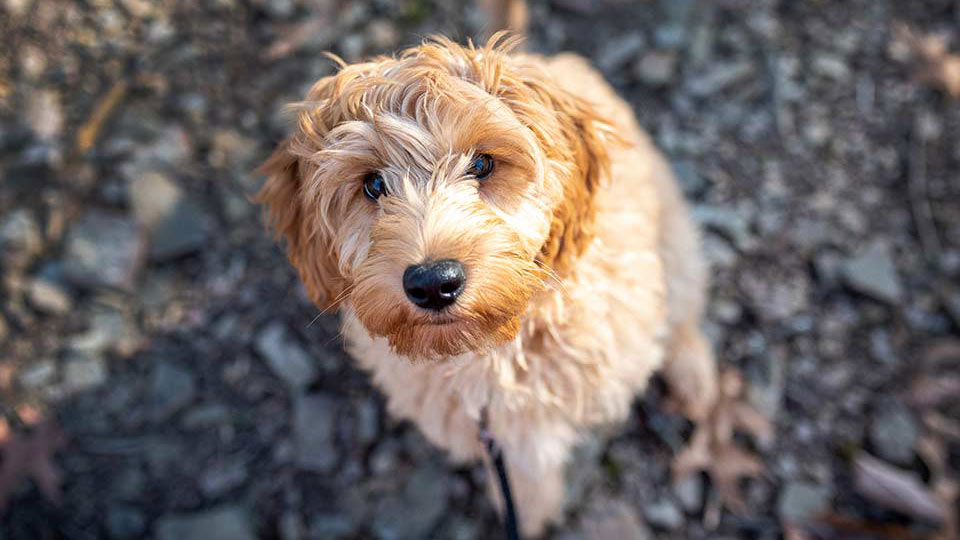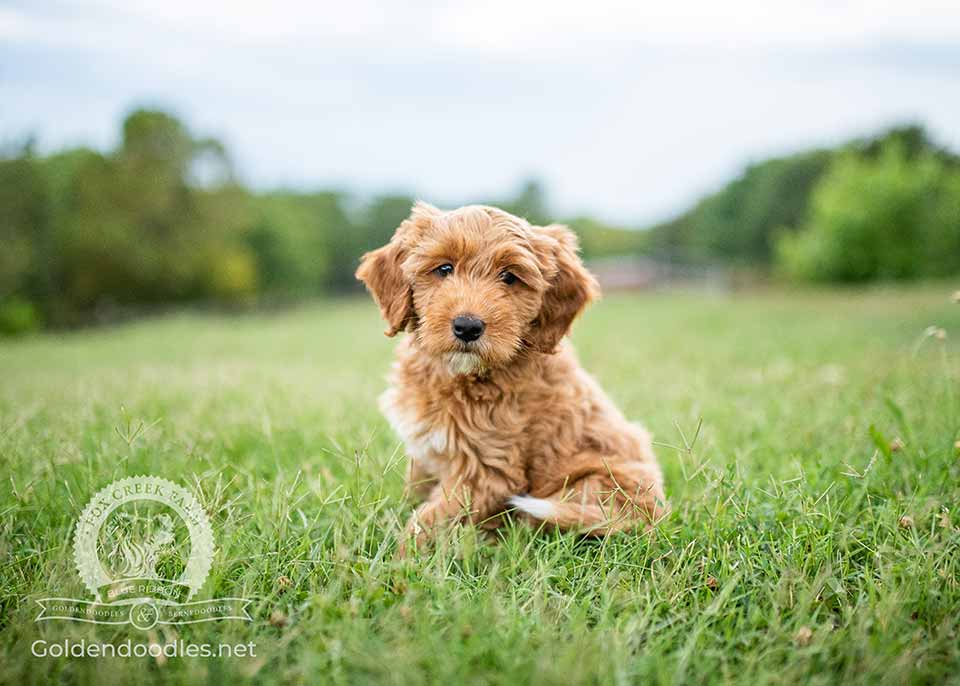
In this article, we will discuss 24 proven strategies that can help relieve your dog of separation anxiety. These separation anxiety tips work with any breed of dog and can make your relationship with your fur baby even stronger.
Let’s set the record straight first, separation anxiety is common among all dog breeds, pure breeds and mixed, so Goldendoodles are no exception. Goldendoodles are a mix of a Poodle and a Golden Retriever and are very eager to please and love being around people. It can be upsetting for dog owners to notice their dogs experiencing separation anxiety. Obviously, if you have a Goldendoodle, you love your dog and want the best for them. No matter what breed you have the following tips are a great place to start in reducing any anxiety.
Some common signs of separation anxiety in dogs are urinating and defecating when left home alone, barking and howling, chewing and destroying things in your home while they’re alone, attempting to escape, and pacing. There are also many reasons a dog may develop separation anxiety, such as a traumatic event, genetic predisposition, changes in their environment, etc.
Obviously, no dog owner wants their pet to be anxious, so we try to help them, but sometimes we help them by teaching them that if they show attention-seeking behaviors, then they will get attention. However, there are many ways to treat separation anxiety in dogs without encouraging them to need our attention. Below are several ways to help your dog with separation anxiety organized in sections of simple tricks, training tips, and other options.
Reduce or Eliminate Separation Anxiety for Your Dog
There are many simple tricks to help your dog feel more comforted when you leave the house. Additionally, there are several modern inventions that make keeping your dog entertained while you’re gone much more simple than it has ever been before. Some easy ways to help your pup with their separation anxiety follow.
1. Turn on the TV
When leaving your dog, you can turn on the TV, music, or a podcast, so your dog feels comforted and as if they are not alone.
2. Leave your scent on their toys
Carry a new toy around in your bag for a few days before giving it to them so it smells like you. This could make your dog feel like you’re there with them even when you’re not.
3. Exercise your pup
Before leaving the house, you could take your Goldendoodle on a walk or play fetch with them. This will tire them out before you leave, so they will be more relaxed and less likely to get anxious after you leave.
4. Anxiety relieving chews
There are several chews on the market to treat symptoms of anxiety in dogs and cats. However, we recommend PawTree’s Chillax chews. Chillax is a veterinarian-developed formula that reduces anxiety symptoms, which would be beneficial to help calm down your dog when you leave the house without them.
5. Puzzle Toys
When you leave the house, you can give a special puzzle toy to your dog that may take a while to eat. For example, you could fill a Kong with peanut butter or low-fat cream cheese and give it to them right before you leave. You could also freeze it so it takes longer for the dog to eat.
Or you could leave your dog with a toy that hides the treats inside so your dog has to figure out how to get the treats. Also, this may lead them to recognize that your leaving isn’t all that scary or awful because they can have a treat while you’re gone.
6. Use a “Thundershirt”
Try using a “Thundershirt” or another type of tight-fitting clothing. This may allow your dog to feel more secure and comforted. It’s comparable to a person using a weighted blanket to reduce anxiety.
7. Use a pheromone spray or diffuser
Pheromone products release properties of natural, positive pheromones. Pets can recognize these positive chemicals, easing anxiety and stress. This could allow your dog to feel more comfortable when you are gone.
8. Treat dispenser
Treat dispensers can be beneficial to keep your dog entertained while you’re gone. There are many different types of treat dispensers that you can choose from too. Some will offer your dog something to chew that is fun. Others will give you the opportunity to remotely release your pet’s treats. Both of these options will provide your dog with mental stimulation while you are gone.
9. Leave something that smells like you
Leaving a sweater or shirt of yours in their crate can help them feel comforted by your scent. However, if you feel like your dog will have an accident or chew on the item, you can leave it on top of their crate so they can still smell you.
10. Brown noise
Brown noise is similar to white noise and is helpful to relax adults, kids, and pets. Leaving brown noise on, whether on a sound machine or the TV, while you’re gone can calm your dog and block out noises from outside that they may normally cause them to get riled.
11. Snuggle puppies
Lots of Goldendoodle breeders recommend a blanket or stuffed animal that provides your Goldendoodle puppy comfort when you first take them home. A comfort stuffed animal or chew toy can be beneficial when your dog is older as well. These Snuggle Puppies have a heat pack and a heartbeat that may help your dog sleep better and not feel alone. Additionally, Fox Creek Farm has these available on hand and the proceeds from buying these go to the Humane Society of Morgan County, a local no-kill shelter.
12. Pet Camera
Using a pet camera can allow you to identify dog separation anxiety since you can track what behaviors they are displaying when you are gone. Additionally, some pet cameras have features where you can speak to your pet through the attached microphone or play a pre-recorded audio. Another cool feature is the treat dispenser attached to the camera which could entertain and reward your dog while you’re away.
13. Training Options
Incorporating some training with these comforting and entertaining techniques is important. Dogs love to please their owners and obviously, if they have separation anxiety, they love your attention. Training your dog gives them the opportunity to please you, gain your attention, and earn treats as a reward for their good behavior. Some ways you can incorporate Goldendoodle training are:
14. Positive reinforcement
Don’t talk to them while they are whining in their crate. Once they are quiet, even for just a few seconds, you can use your marker, such as “yes,” “good boy/girl,” or “good.” This will teach your dog that you want them to be quiet when they are in their crate. It will also make them realize they will only get attention when they are quiet.
Also, never let them out of their crate when they are whining. Wait for them to pause and then let them out. You can practice using a marker, like “yes,” when they are quiet in their crate a few times a week for about 15 minutes at a time.
15. Practice with treats
Put your dog in the crate in a room next to the door and wait outside the door until they are quiet. Once they are quiet, walk in and say your marker, such as “yes” or “good” and put a treat in their crate. Then walk out again and repeat this a few times in a row and do it a couple of times a week. Soon your Goldendoodle will realize they won’t get attention or treats until they are quiet. Once they get the hang of it, you can gradually increase the time between shutting the door and giving them a treat.
16. Don’t make a big deal about leaving or coming home
When you leave the house, don’t prolong the departure or act sad, this will confirm their reasoning for getting distressed. When you arrive back at the house, don’t acknowledge your dog until they have calmed down. When you acknowledge your dog when they’re excited, you’re encouraging attention-seeking behaviors. Once they calm down, you can greet them. This teaches them that they get attention when they are behaving and quiet.
17. Don’t scold or punish your dog
When dealing with Goldendoodle separation anxiety, don’t scold or punish your dog. Positive reinforcement typically works better with dogs, especially because they’re already anxious about you leaving. So reward the behaviors you want them to be doing rather than punishing the behaviors you don’t want them doing.
A good rule of thumb with positive reinforcement is to just ignore their negative behaviors if they are trying to seek your attention. Some examples of attention-seeking behaviors are whining while in their crate, jumping up on you, and barking and howling when you shut a door on them and they can’t get in.
18. Leave your dog with a close friend or family member
Leaving your dog with a close friend or family member that they are familiar with for short periods of time can train your dog to get used to being away from you. So in the future, they may display less distressing behaviors after you leave them at the house.
19. Practice without leaving
If your dog shows signs of anxiety when you’re getting ready to leave such as when you’re putting on your coat, putting on makeup, or grabbing your keys, you can do these without leaving. For example, you can grab your keys and sit at the table for a few minutes until they calm down or you could put on your coat and then watch some TV. Doing this will teach your dog that these cues don’t always mean you’re going to leave and will prevent them from panicking every time it happens.
Other Options
If training and simple tricks don’t work for your dog, there are still a couple of options. These may be more expensive options or may occupy more of your time, but they may still be very beneficial when dealing with Goldendoodle separation anxiety. These options are below.
20. Get another dog
Some dogs feel more stimulated and comforted when they have another dog with them. So basically, you can get an emotional support dog for your dog.
21. Doggy daycare
Sometimes dogs may not be able to stay home alone so a dog sitter or doggy daycare may be the best option. This would provide them with stimulation and exercise throughout the day.
22. Don’t leave your dog in the crate for too long
It’s recommended to leave a 2-month-old puppy in the crate for only 3 hours consecutively. You can add an additional hour each month until your Goldendoodle is about 6 months old and potty trained. You should never leave your dog in a crate for longer than 8 hours. The recommended maximum amount of time to leave a dog in their crate is 6-8 hours.
Leaving your dog in the crate for hours at a time will teach them to be more upset and anxious when you leave the house. It can also be damaging to their mental and physical health. As a solution, you could come home from work during lunch and take your dog on a walk, have a family member stop by in the middle of the day, or hire someone to take your pet on a walk midday so your dog can get a break from their crate.
23. Be consistent
Having a routine can be helpful for dogs. Leaving the house around the same time each day and arriving home around the same time each day will provide your dog with some form of structure. A routine can prepare dogs for when you will leave the house and they will be prepared for when they will have alone time.
24. Consult a veterinarian
Consulting a veterinarian may be a good next step if none of the above tactics work. There is a possibility that your dog may have an underlying medical condition that is causing their anxiety. A veterinarian can also put you in touch with a veterinary behaviorist who could manage your dog’s behavior problems and improve the well-being of your dog.
Separation anxiety can be a tough issue to solve, but with some patience, love, and clever techniques, you and your cuddly teddy bear can say goodbye to stress and hello to calm. We hope these tips prove useful to help calm your dog while you are away.
Responsible pet owners know that selecting a Goldendoodle breeder is difficult. Since 1999 Fox Creek Farm has earned the reputation of a responsible Goldendoodle breeder that finds the temperament and health of your pup incredibly important. Additionally, you can always rely on us to offer tips and tricks for you and your pup to have a happy and relaxing life together.





